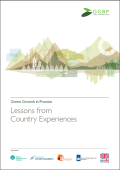This compendium explores greening the economy on four levels – individual, business, city, and nation. It looks at the relationships between these levels and gives many practical examples of the complexities and solutions across the levels. Scandinavia, a pioneering place advancing sustainability and combating climate change, is a unique starting point for learning about greening economies. The study includes many initiatives implemented in Scandinavia since the 1970s that are all potentially useful for other countries and contexts. Throughout this compendium, the user will find many examples with links to relevant websites, documents and films.

At the Davos forum of January 2014, a group of 14 countries pledged to launch negotiations on liberalizing trade in "green goods" (also known as "environmental" goods), focusing on the elimination of tariffs for an Asia-Pacific Economic Cooperation list of 54 products. The paper shows that the Davos group, with an average tariff of 1.8 percent, has little to offer as countries have avoided submitting products with tariff peaks for tariff reductions. Even if the list were extended to the 411 products on the World Trade Organization list, taking into account tariff dispersion, the tariff structure on environmental goods would be equivalent to a uniform tariff of 3.4 percent, about half the uniform tariff-equivalent for non-environmental goods. Enlarging the number of participants to low-income countries might be possible as, on average, their imports would not increase by more than 8 percent. However, because of the strong complementarities between trade in environmental goods and trade in environmental services, these should also be brought to the negotiation table, although difficulties in reaching agreement on their scope are likely to be great.


Green growth is becoming an attractive opportunity for countries around the world to achieve poverty reduction, environmental protection, resource efficiency and economic growth in an integrated way. Green growth strategies generate policies and programs that deliver these goals simultaneously. They accelerate investment in resource efficient technologies and new industries, while managing costs and risks to domestic taxpayers, businesses, communities and consumers.
This report carried out by the Green Growth Best Practice (GGBP) initiative, is the first comprehensive international assessment of lessons from experiences of pursuing green growth across all levels of government and all regions. The report is the result of a collaborative partnership between the Climate & Development Knowledge Network (CDKN), the European Climate Foundation (ECF) and the Global Green Growth Institute (GGGI). It engaged 75 authors in evaluating more than 60 programs around the world.
Fossil-fuel subsidies matter: for sustainable development; for government budgets; for the poor; for women; and for the environment. Subsidies amounted to $544 billion (2012) and are largest in MENA and Southeast Asia. Reforming and redirecting subsidies will be an important piece of the jigsaw if we are to solve the climate change puzzle. Savings enable governments to manage deficits; could be redirected at building energy networks; or targeted at social spending. This paper finds opportunities for Nordic countries to increase cooperation around reform and makes specific recommendations. The paper is part of the Nordic Prime Ministers' overall green growth initiative.
